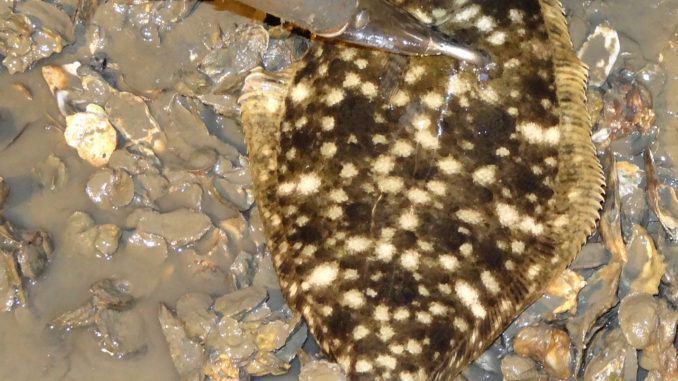
For knowledgeable anglers, there’s always more than one way to get your doormat flounder. Flounder fishing with rod and reel is fun, but gigging at night can be awesome.
According to Mike Cox of Awendaw, there’s a unique perspective to saltwater creeks and waterways at night. With powerful beams of lights directed at the water, nocturnal fishermen can see a myriad of sea life in the shallows; blue crabs, shrimp, redfish, sheepshead and assorted species of forage fish are abundant. But of particular interest to many of these night prowlers are the doormat-sized flounder, which thrive as ambush predators and are settled on the bottom in mere inches of water, waiting to chow down on unsuspecting prey. And the nocturnal hours can be prime time.
“During the nocturnal hours, especially on the dark phase of the moon, these fish will move very shallow near the water’s edge, often in mere inches of water and settle in on the bottom to ambush their forage as it swims by,” he said.
Cox said flounder gigging is as simple as rigging lights on your boat so you can see in front of and alongside the bow. Then, employ a long, poled gig to pole and push the boat along. Going with the tide is preferable, and flounder are gigged as soon as they’re spotted.
“I use a big generator to run two 500-watt lights on my boat,” he said. “I can effectively cover a wide area of the shallow bottom in front of and alongside the boat. However, a high-profile rig such as this is not essential to flounder gigging success.
“When I started gigging, I had a much simpler rig, and it was very inexpensive,” he said. “It still works and simply consists of a couple of big marine batteries and a series of three 100-watt, 12-volt lights as the light source. I put the lights in metal reflectors to help direct the beam onto the water.
“Even with this simple rig, I was able to gig a lot of flounder if I gigged the last couple hours of the dropping and the first couple hours of the incoming tide,” Cox said. “Essentially, the time to gig is from when the water comes out of the grass until it gets too far back in to see the bottom at the edge.”
Cox said the gig consists of a 10- to 12-foot wooden or aluminum pole to which you attach the gig. More expensive, commercial gigging poles are available and designed just for this sport; they’re made of almost indestructible fiberglass.
Cox prefers a shell bank littered with open areas of sand or hard bottom. Sandy bottoms are always potentially good, and the areas around the mouths of small tidal creeks can be prime.
“The small point of shells that form in these creek junctions are ideal ambush points for flounder at night,” he said. “That’s why they’ll move into these places to forage. Also, shell pods that rise up in the middle of small creeks are hotspots as well. I’ll pole completely around these places, taking my time to find the fish. Often, you’ll find several fish in a small, localized area. The action does get fast-paced at times. When you can stick the gig in one flounder and count a half-dozen more in the beam of light, you’re in business.” Cox said.





Be the first to comment